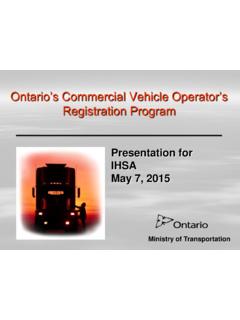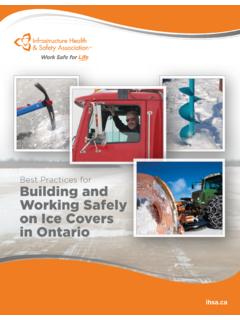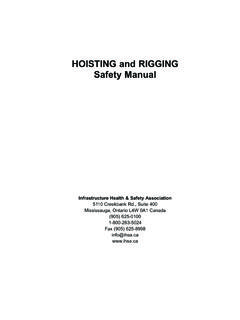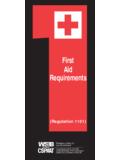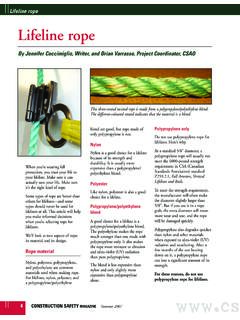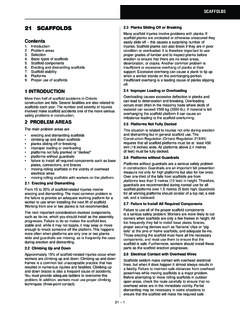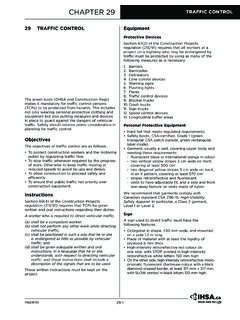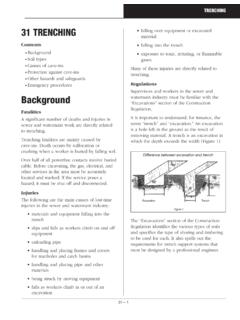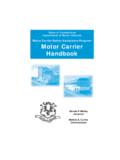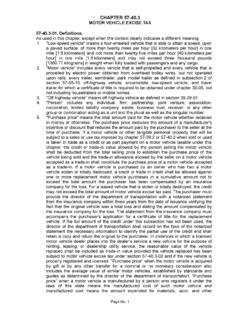Transcription of Commercial Vehicle Safety & Compliance - IHSA
1 Commercial Vehicle Safety & Compliance Presented for: May 7, 2015 Commercial Vehicle Safety 2 Purpose To provide an overview of MTO s Commercial truck and bus Safety and enforcement program. Commercial Vehicle Safety 3 Program Objective Support road Safety by reducing collisions and fatalities involving Commercial Motor Vehicles (CMV) Commercial Vehicle Safety 4 Trade: Annually, $ trillion worth of goods is moved by trucks expected to double in the next 30 years. Ontario s two-way trade with the totals ~$280 billion per year ~ 80% of Ontario s trade with the moves by truck Traffic Growth and Density: million registered Commercial vehicles 267,800 trucks and 33,000 buses 585,000 Commercial drivers More than million trucks cross the border last year Operating Environment Commercial Vehicle Safety 5 Strategic Approach Maintaining Relevant Safety Standards Developing and continuously improving the driver, Vehicle and carrier standards to improve road Safety .
2 Risk Based Detection Utilise programs aimed at better identification of low and higher risk carriers to more effectively direct enforcement resources and remedial programs ( CVOR system, directing enforcement resources along known bypass routes). Deterrence Imposition of strong deterrent measures to encourage Compliance ( increased fines and aggressive legislation CMV Impoundment). Incentives Introduction of meaningful incentives to reward industry investments in Safety ( MTO contracts for safe carriers, pre-clearance, CVOR Renewal etc.). Commercial Vehicle Safety 6 Program Impacts Over a 70% reduction in the number of reported wheel separations since the mid- 90 s (215 in 1997). 78% of trucks inspected during 2014 RoadCheck were found to be in Compliance .
3 Approximately 121,000 trucks, buses and drivers are inspected by MTO annually. More than 28,000 charges laid. 715 facility audits of carriers. Over 2,300 unsafe Commercial vehicles impounded since 1998. Between 2000 and 2010, the large truck population in Ontario grew by , while the number of fatal collisions involving large trucks decreased by 28% during the same period. Commercial Vehicle Safety 2014 Inspections By Agency (total= 121,087) Minister s Briefing 7 Commercial Vehicle Safety RoadCheck Compliance Comparison Minister s Briefing 8 Commercial Vehicle Safety Fatalities Involving Large Trucks Preliminary 2011 Fatalities = 100 Commercial Vehicle Safety 10 Key Enforcement Activities On-road inspections (TIS and area patrol) Facility Audits Commercial Vehicle impoundment School bus and motor coach inspections Weight and dimensions enforcement Dangerous goods inspections Issuance of oversize/overweight permits Motor Vehicle Inspection Station investigations and audits Promote education and awareness Respond to public enquiries and liaise with local constituency offices Emerging issues (speed limiters, tow trucks, aggregate enf.)
4 Commercial Vehicle Safety 11 Deployment high volume corridors, at the gateways inbound to Ontario and inbound to large urban areas (Toronto, Ottawa), where the potential for personal injury and fatalities is relatively higher, where current out-of-service rates and non- Compliance are known to be higher, where Commercial Vehicle collision rates are relatively higher, and at known truck bypass routes, problem industry sectors and in specific geographic areas. Detection Strategy: Enforcement resources are deployed strategically using a risk-based, time sensitive approach: Commercial Vehicle Safety 12 carrier Safety & Enforcement Program Field Resources Include: 4 Regions 13 Districts 340 Transportation Enforcement Officers 32 fixed truck inspection stations (TIS) Includes 15 Commercial Vehicle Impoundment Program stations 69 lay-by locations 2 Mobile TIS (staffed seasonally) ~ 180 enforcement vehicles Commercial Vehicle Safety What is a Commercial Motor Vehicle What is a Commercial Motor Vehicle ?
5 Highway Traffic Act Section 1 Commercial Motor Vehicle means a motor Vehicle having permanently attached thereto a truck or delivery body and includes ambulances, hearses, casket wagons, fire apparatus, buses and tractors used for hauling purposes on the highways; Commercial Vehicle Safety 14 The On-Road Inspection Process Commercial vehicles with a gross weight of 4,500 kg or more are required to enter TISs when directed by signals and signage on the highway. Officers select vehicles for inspection based on: Year/type of Vehicle Mechanical condition Load characteristics Safety requirements Permitting/licensing requirements Weight/dimensional Compliance MTO enforcement officers also patrol bypass routes to detect trucks avoiding inspection stations.
6 Commercial Vehicle Safety 15 The Inspection Process Commercial vehicles are inspected to North American standards set out by the Commercial Vehicle Safety Alliance (CVSA). Vehicles selected for inspection may be subject to either a Level 1 , Level 2 or Level 3 CVSA inspection. A Level 3 inspection involves an inspection of the driver s license; hours of service; seat belt; Vehicle inspection report; and HM requirements. A Level 2 inspection involves inspection of the driver s documentation and a walk-around inspection of the Vehicle and load to observe any obvious Safety violations and document check. A Level 1 inspection involves a more in-depth inspection including items from a Level 3 as well as a full physical examination of the Commercial Vehicle . Any defects or non- Compliance found by an officer are recorded on a report and forwarded to St.
7 Catharines for inclusion on the carrier s Safety record. Commercial Vehicle Safety 16 The Inspection Process (cont d) Where an inspection reveals no violations, the driver and Vehicle is allowed to proceed. In cases where violations are detected, enforcement officers may issue a warning or charge the driver, owner or operator of the Vehicle . Vehicles that are found to have out-of-service Vehicle defects must have the defects repaired before proceeding. A Commercial Vehicle found to be critically defective would be impounded for 15 days. Second and third incidents with the same Commercial Vehicle over a two-year period carry a 30 and 60 day impound period, respectively. Commercial Vehicle Safety 17 carrier Services The MTO offers a variety of services to the Commercial Vehicle industry in Ontario.
8 MTO responsible for the administration of: Commercial Vehicle Operator s Registration (CVOR) Over-weight/over-dimensional (O/O permits) Motor Vehicle inspections station (MVIS) licensing and inspection certificates, and mandatory Vehicle branding Hours of Service (O. Reg. 555/06) Commercial Vehicle Safety Hours of Service (O. Reg. 555/06) Applies to a Commercial motor Vehicle as defined by HTA section 16(1). Exemptions from Regulation Does not apply to: A driver while driving a pick-up truck that, a)is being used for personal purposes without compensation; and b)is not carrying, or towing a trailer that is carrying, Commercial cargo or tools or equipment of a type normally used for Commercial purposes. Commercial Vehicle Safety Hours of Service (O.
9 Reg. 555/06) What is a Pick-up truck ? Means a Commercial motor Vehicle that, a)has a manufacturer s gross Vehicle weight rating of 6,000 kilograms or less, and b)is fitted with either, original box that was installed by the manufacturer, which has not been modified, or replacement box that duplicates the one that was installed by the manufacturer, which has not been modified. Commercial Vehicle Safety Hours of Service Driver Responsibilities: Must not drive after being on-duty for: 70 hours in 7 consecutive days; 120 hours in 14 consecutive days provided driver has 24 hours off-duty within the 14 day period. Commercial Vehicle Safety Hours of Service Driver responsibilities: Driver cannot drive after: 13 hours driving time within a single day or work shift 14 hours on-duty time within a single day or work shift 16 hours elapsed time from end of last 8 or more consecutive hours off-duty.
10 Note: on-duty means any time driver performs activities for an operator as an employee except for time during which operator relieves the driver from responsibility. Commercial Vehicle Safety Hours of Service Driver s Daily Log 14 0 7 2 24 Commercial Vehicle Safety Exception to Daily Log Requirement 18. (1) A driver is not required to keep a daily log for a day if the driver, (a) on the operator s instructions, drives a Commercial motor Vehicle solely within a radius of 160 kilometres of the location at which the driver starts the day; and (b) returns at the end of the day to the same location from which he or she started. (2) Subsection (1) does not apply to a driver who is driving under a permit issued under section 191 of the Act. Commercial Vehicle Safety Exception to Daily Log Requirement (3) If a driver is not required to keep a daily log for a day pursuant to subsection (1), the operator shall keep a record for the day showing, (a) the date, the driver s name and the location at which the driver starts and ends the day; (b) the cycle the driver is following; (c) the hour at which each duty status starts and ends and the total number of hours spent in each duty status; and (d) the number of hours of on-duty time and the number of hours of off-duty time, within the meaning of this Regulation, that the driver accumulated each day during the 14 days immediately before the start of the day, for which the driver was exempt from this Regulation and not required to keep a daily log.
